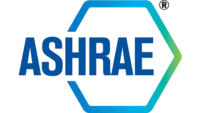In April, the U.S. Department of Energy (DOE) released its national blueprint for decarbonizing U.S. buildings by 2050. The blueprint aims to reduce greenhouse gas emissions from U.S. buildings 65% by 2035 and 90% by 2050 vs. 2005 levels and includes action the federal government can take to meet specific targets for increasing building energy efficiency, accelerating onsite emissions reductions, transforming the grid edge, and minimizing embodied life cycle emissions.
According to DOE, buildings are responsible for more than a third of total U.S. greenhouse gas emissions, therefore achieving building decarbonization is critical for reaching net-zero emissions economy-wide.
“Approximately 40% of existing buildings were built prior to 1980, and the World Economic Forum estimates that 80% of these buildings will still be in use as the world approaches the net zero goal posts in 2050,” says Mark Lessans, senior director of sustainability and regulatory affairs for Johnson Controls. “Many of these aging facilities were not designed with greenhouse gas emissions (GHG) in mind. With nearly 40% of carbon emissions attributable to the built environment, retrofitting these buildings will be critical to addressing the challenges posed by climate change. By operating more sustainably and leveraging advanced HVAC technology and controls, buildings have the potential to significantly contribute to climate change mitigation.”
Jim Nolan, market development manager at Xylem, agrees, noting that commercial buildings alone emit 16% of CO2 emissions in the U.S.
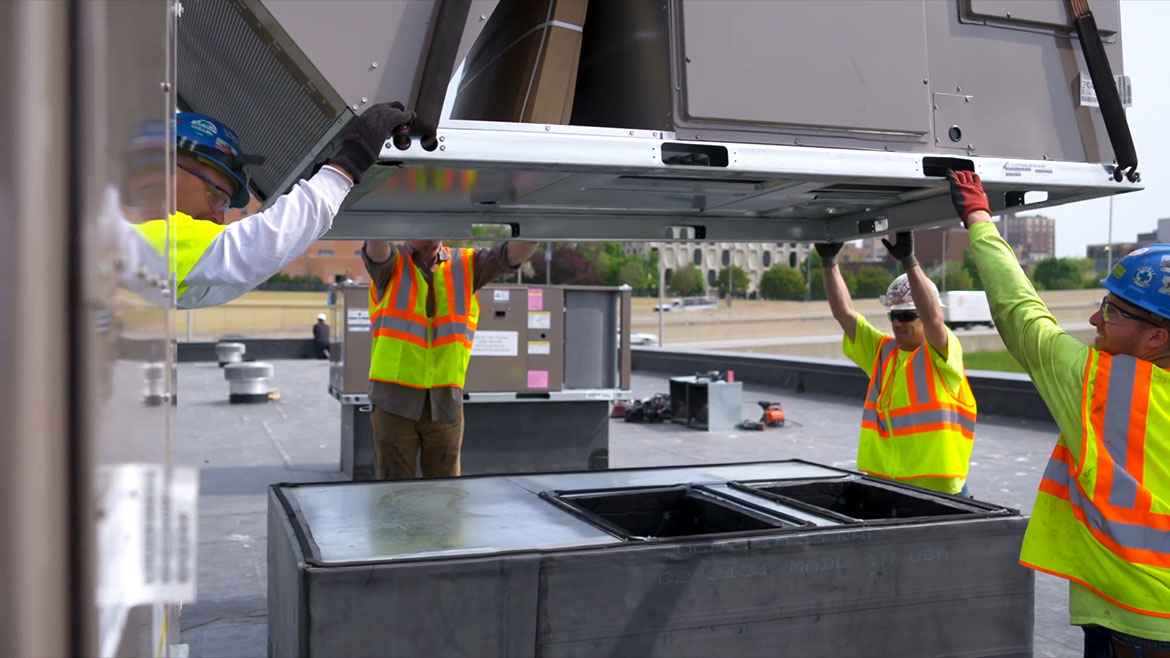
Johnson Controls' Mark Lessans notes that many existing aging facilities were not designed with greenhouse gas emissions (GHG) in mind, therefore retrofitting these buildings will be critical to addressing the challenges posed by climate change.
“Since about 80% of buildings targeted for decarbonization are already standing, with many of them over 10-15 years old, focusing on these buildings is the quickest way to cut emissions,” he says. “Hydronic systems are a great solution for this because they use water, which has a zero Global Warming Potential (GWP) compared to refrigerants and can integrate with a wide variety of heating and cooling sources. Additionally, hydronics are technology agnostic, adaptable and easily integrated with other technologies. Water-sourced heat pumps, geothermal systems and water-sourced VRF systems that are already in place will support the expansion of hydronic systems, providing more opportunities to achieve carbon-neutral buildings.”
Amy Turner, vice president of marketing, Intellihot, adds that the retrofit market is a projectable, consistent source of activity and stable growth.
“We’ve invested considerable resources to make retrofitting easy and cost-effective for contractors and building owners,” she says. “Most of our retrofit work is replacing conventional tank-type water heaters that run 24/7/365, while waiting to be used. Intellihot units use 40% less energy than these conventional tank types. Plus, all our units are designed for simple and quick installation. As of 2023, Intellihot products saved 12.3 billion pounds of CO2 emissions. Installing water heaters like ours is one of the easier things for building owners to do to get a building more energy efficient.”
Is decarbonization achievable?
While government legislation is driving building decarbonization goals, there is some industry skepticism of the reality of meeting these expectations.
“Most people believe that reducing carbon in the atmosphere will reduce global warming — I tend to agree with this, but not necessarily the pace, politics and methodology used to move us in that direction,” notes John Siegenthaler, PE, principal, Appropriate Designs, Patent Holland, New York, and PM Engineer columnist. “The approach has to be rational and realistic, rather than a political race to see which state has the best carbon reduction virtue signaling. I’ve already seen local evidence of electrical grid overloading in extreme weather, and expect this will get worse before it gets better. The U.S. can decarbonize, but trying to do it over five years rather than 30+ years in not realistic.”
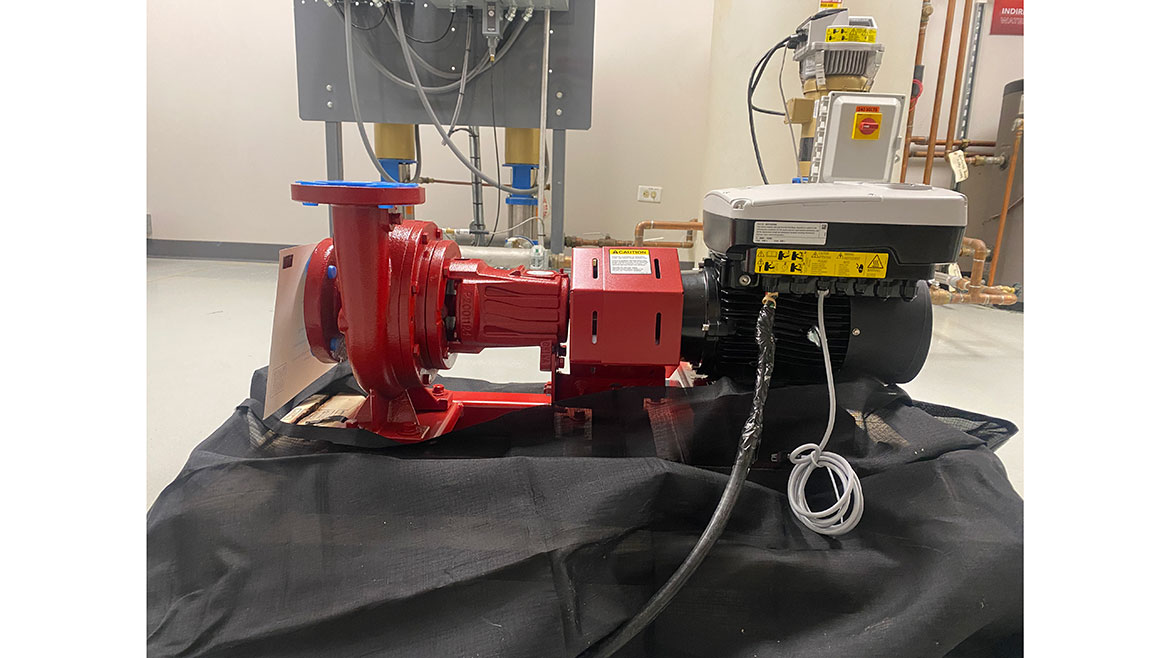
Xylem's Jim Nolan notes, "Achieving decarbonization goals requires a shift in both the way buildings are operated and maintained. Taking advantage of government incentives is one thing, but educating and creating a culture of energy efficiency and sustainability among all stakeholders is another entirely."
Siegenthaler adds there is an over-expectation that moving completely away from fossil fuels to electricity is the proper course.
“For example: A typical heat pump with a COP of 3.0 will use about 1/3 the amount of electricity as a direct conversion of electricity to heat,” he explains. “However, if that electricity comes from a utility plant operating on natural gas, the efficiency of converting the gas to electricity is only about 33%. There is also line loss in passing electricity over utility distribution systems. The net effect of the above is roughly equivalent to that of a high-efficiency boiler burning the gas directly. The resulting carbon offset is minimal, if any. From an energy standpoint only, moving HVAC from fossil fuel to electricity makes sense if the added electrical load is coming from renewable sources (solar PV, utility-scale wind, hydro, or nuclear). From a carbon accounting standpoint, the life cycle cost of all renewables should be evaluated starting with raw materials, refinement, transportation, installation, maintenance and eventual disposal cost. It’s not just about the energy they produce, it’s also about the embodied energy to create and operate the system.”
Nolan notes that decarbonization needs to happen in phases, not overnight.
“It will take years for the infrastructure to sustainably deliver the electricity needed to make a real impact on decarbonization,” he says. “What’s more, the financial burden in retrofitting existing buildings and incorporating advanced technology in new construction is extensive. While government incentives and subsidies can alleviate some of these costs, the initial investment required can be substantial. Achieving decarbonization goals requires a shift in both the way buildings are operated and maintained. Taking advantage of government incentives is one thing, but educating and creating a culture of energy efficiency and sustainability among all stakeholders is another entirely. Despite some challenges, innovative financing options, technological advancements and renewable energy sources are continuously improving the feasibility of meeting these goals.”
Turner notes the ability to meet aggressive decarbonization goals differs on a case-to-case basis.
“When upgrades are challenging to fit into renovation scope/budgets, we advise property owners to take smaller, yet meaningful, steps towards decarbonization with a holistic approach — focusing on the entire property’s energy consumption and conservation across multiple functions. For example, if complete electrification of hot water systems is not possible, a hybrid hot water system with heat pumps and gas units for supplemental heat can be a great alternative, providing a cost-effective pathway for properties to reduce their carbon emissions.”
Lessans adds that while government policy is a major push driving building decarbonization, he is also seeing market “pulls” that help bring us closer to decarbonization goals.
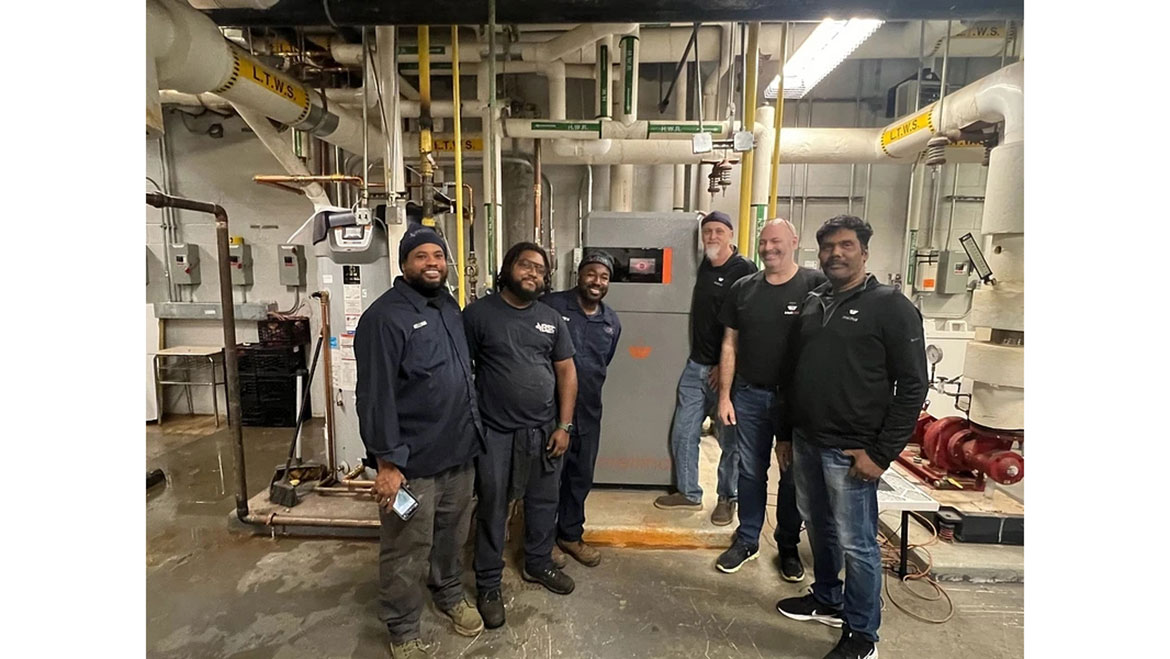
Installers standing in front of a successful Intellihot Electron installation.
“These ‘pulls’ are driven by stakeholders in the private sector that increasingly view climate change as a risk to business operations and are demanding more transparency on organizations’ plans to mitigate that risk,” he says. “As a result, companies are looking closely at their own building emissions and charting paths to reducing them. It’s both government policy and market demand that will make achieving our climate goals a reality.”
Reducing carbon emissions
So how can buildings optimize their plumbing and mechanical systems to reduce carbon emissions?
“Start with the ‘low hanging fruit’ — building heat loss and heat gain,” Siegenthaler advises. “Reducing load not only reduces operating cost, it reduces the size of equipment and peak load. The ROI on energy conservation is usually better than that of high-performance HVAC.”
Turner notes that “optimization” is the keyword, and the right equipment for improved sustainability is just part of the solution.
“The equipment must also be sized correctly,” she says. “Too often we see the benefits of technology going to waste when the equipment is not sized optimally for the specific job. Intellihot’s sizing tool uses a database of thousands of similar-use facilities, including real-world flow profiles, geographic locations, outlet temperature preferences, and more, allowing customers to move well beyond assumption-based projections to real-life usage. This approach offers an even more robust sizing selection than flow meter data alone, as it leverages real-world data from sites across the country that have similar usage patterns. Additionally, this data is not limited to a seven-day analysis period, but rather, is able to span thousands of hours of operation, accounting for variations in usage characteristics. We’re so confident in this sizing tool that we offer free additional equipment if our sizing projections fail to produce the necessary volume of hot water.”
Since over half of commercial building energy consumption in the U.S. is attributable to HVAC systems, it creates a huge opportunity to reduce emissions, Lessans explains.
“A good place to start is to deploy digital, connected controls at the building or equipment level, which can fully optimize equipment for maximum energy efficiency and maintain occupant comfort,” he says. “When HVAC equipment is ready for replacement, high-efficiency equipment with low or ultra-low global warming potential (GWP) refrigerants should be installed. Finally, heating systems that burn fossil fuels on-site can be fully or partially replaced by heat pumps; generally, building managers can consider replacing furnaces with air-source heat pumps and boilers with air-to-water or water-to-water heat pump chillers. All of these solutions can slash building emissions while also significantly reducing operating expenses.”
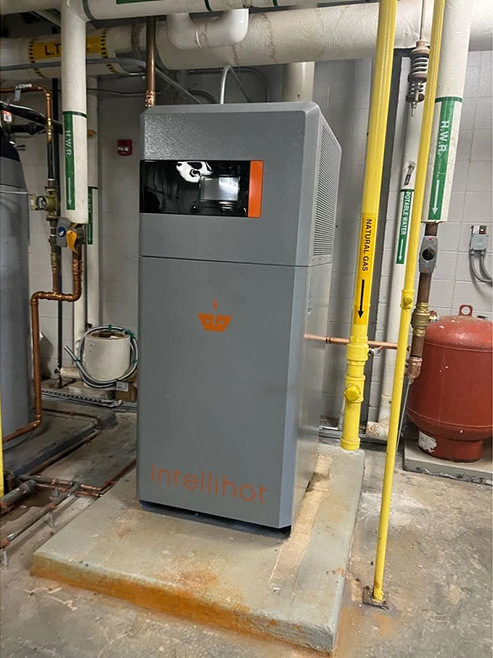

The Intellihot Electron is an air source heat pump that absorbs heat from the air and stores it in a specially designed thermal battery. This thermal battery contains a special blend of a water-glycol mix for heat storage along with a unique tankless heat exchanger built inside. When there is a demand, domestic water flows through this heat exchanger and is heated to precisely the right temperature, and is available for use immediately, the company says.
According to Nolan, most existing buildings today over three floors will have a hydronic heating and cooling system, and, in the U.S. alone, 30% of commercial floor space is heated with a boiler. And most of these buildings are larger than 50,000 square feet.
“When we think about decarbonizing existing buildings, the primary opportunity really lies in identifying ways to make upgrades and enhancements with what is at hand,” Nolan says. “Hydronic systems are key in these efforts, as they offer building professionals the opportunity to scale a system up or down, make upgrades or enhancements to existing equipment or tailor a piping configuration based on a specific application or building type. It's not just about hydronic systems, though; other opportunities to advance decarbonization in existing buildings involve incorporating smart technologies like remote monitoring solutions that proactively assess pump performance or digital tools that integrate with building management systems (BMS). If we look at existing buildings as an opportunity rather than an obstacle, we can begin to make strides in sustainability.”
Success stories
According to Turner, Turtle Bay Resort in Oahu, Hawaii, is a good example of Intellihot’s efficient systems in action.
“The property replaced almost 4,000 gallons of hot water storage with just two Intellihot tankless units — each delivering 1.5 million Btu/h,” she says. “As a result, the property was able to save $90,000 annually on its gas bills with a quick ROI of three years. This was possible due to the Intellihot units using significantly less energy, and less energy usage also translates to lower emissions being generated.”
Lessans notes that since 2000, Johnson Controls has generated more than $8.4 billion in energy and operational savings and mitigated nearly 39 million metric tons of carbon dioxide for its customers through sustainable infrastructure projects.
“At the same time, we’ve accelerated progress on our own commitment to the Climate Pledge, to achieve net zero Scope 1 and 2 emissions by 2040,” he says. “One key step on this journey to net zero is the completion of a comprehensive sustainability project at our Norman, Oklahoma, manufacturing facility.”
The Johnson Controls Norman plant, a 900,000 square-foot flagship facility for research, manufacturing and testing of Johnson Controls HVAC rooftop units, faced common industry challenges in managing its environmental impact.
“To improve site sustainability, we installed a more efficient central heating and cooling plant, a new compressed air system, plug load controls and a high- and low-voltage transformer replacement,” Lessans says. “Additionally, we installed a 1.56-megawatt carport solar-photovoltaic solution, along with vehicle charging stations, to generate on-site renewable energy. To further support and track our progress toward net zero, the facility will use the Johnson Controls OpenBlue digital platform to automate emissions reporting and provide greater insights through data.
“In total, this plant modernization project is projected to generate $960,000 in annual utility savings and reduce site emissions by 43%, making a significant reduction in our operational emissions and bringing us closer to net zero by 2040,” he continues. “It also creates a blueprint for global organizations seeking to implement building modernization projects that bring value to owners, employees, investors and communities.”
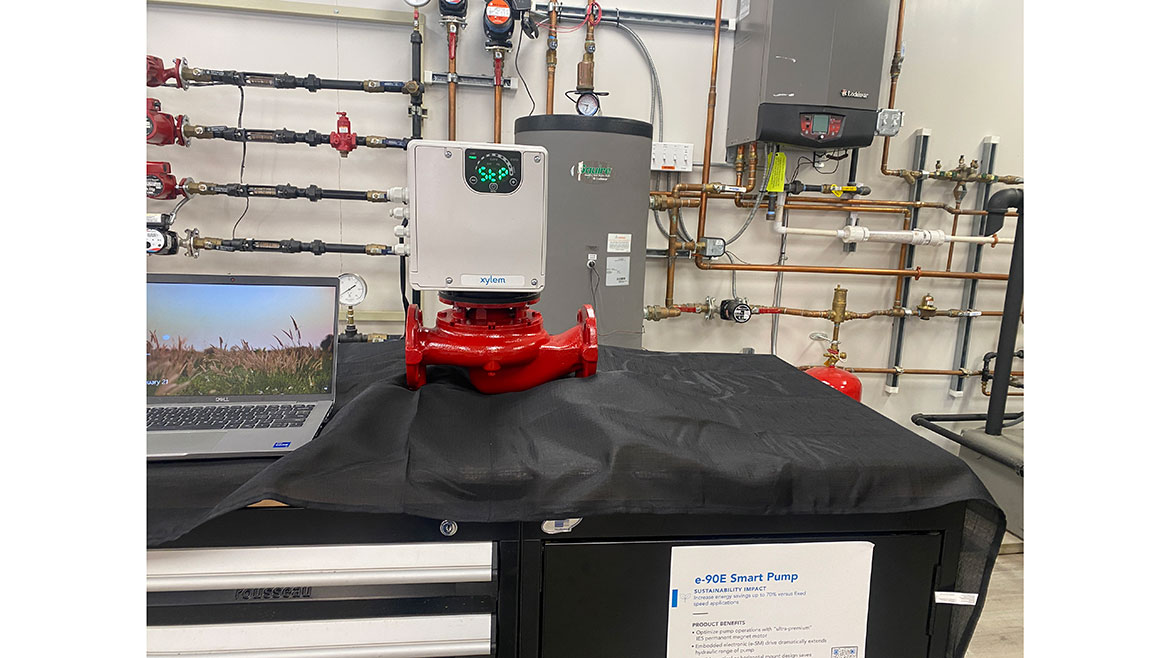
Bell & Gossett's Series e-90E Smart Pumps are designed for small commercial HVAC systems with a wide range of applications including hydronic heating and cooling, pressure boosting, refrigeration and heat exchanger circulation. They are available in bronze fitted or all bronze construction to meet a wide range of pump needs.
Future market trends
The HVAC industry is evolving in response to the need to decarbonize the built environment, creating new opportunities for the entire value chain, Lessans notes.
“The industry can expect a wider range of heat pump options, both in breadth of application and in proportion of heating load,” he says. “Well-informed engineers and contractors can position themselves as advisors to meet each customer’s unique needs for cost-effectiveness, regulatory compliance and sustainability goals while taking advantage of available incentives. New digital solutions like fault detection and diagnostics enable visibility into equipment performance, creating more opportunities for remote optimization and on-site service.
“In addition to advancements in HVAC equipment itself, taking a comprehensive approach to building energy management will drive even greater progress toward net zero goals,” Lessans adds. “Intelligent building controls can provide a holistic view into contextual, full-building performance and help building managers optimize system- and component-level assets. As these digital solutions ‘learn’ from an ever-growing data set, they can provide deeper insights that enable greater cost savings, emissions reductions and occupant experiences. It is critical that building managers are aware of available HVAC systems and digital technologies to achieve the lowest carbon footprint possible.”
Turner points to electrification as the future of the commercial building market. “With the invention and introduction of the Electron tankless heat pump water heater, Intellihot made a significant investment in the future of electrification. It has the efficiency of heat pumps with the safety, on-demand performance, and space-saving of tankless water heaters. Policies and incentives in ‘blue states’ today will drive early adoption. We believe ‘red’ and ‘purple’ states are not far behind, too. We see many plumbing engineering firms working towards electrification in multiple states. Once such engineers become familiar with the benefits of our units, and the applicable incentives they qualify for, Intellihot’s products often top their recommendation list.”
The industry has come a long way in decarbonization efforts, but there’s still a long way to go, according to Nolan.
“With this in mind, I foresee a growing focus on education and collaboration to help bridge the gap between homeowners, design professionals, architects, engineers, government agencies, plumbers and contractors alike,” he says. “Through efforts like ASHRAE’s Decarbonization Conference, international trade shows and educational and training initiatives like Bell & Gossett’s Little Red Schoolhouse, we are slowly seeing it start to make a real difference. I also foresee a growing focus on connectivity and digitization, with more integration of smart technologies that are compatible with Wi-FI and track in real-time the performance of pumps and other assets. Finally, a focus on end-to-end solutions that holistically address the built environment will be crucial to effectively address the challenge of decarbonization.”




